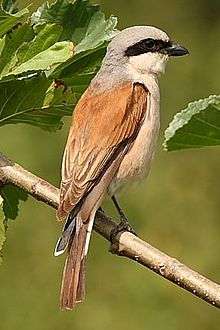Red-backed shrike
| Red-backed shrike | |
|---|---|
 | |
| Adult male | |
| Scientific classification | |
| Kingdom: | Animalia |
| Phylum: | Chordata |
| Class: | Aves |
| Order: | Passeriformes |
| Family: | Laniidae |
| Genus: | Lanius |
| Species: | L. collurio |
| Binomial name | |
| Lanius collurio Linnaeus, 1758 | |
The red-backed shrike (Lanius collurio) is a carnivorous passerine bird and member of the shrike family Laniidae. The genus name, Lanius, is derived from the Latin word for "butcher", and some shrikes are also known as "butcher birds" because of their feeding habits. The specific collurio is from Ancient Greek kollurion, a bird mentioned by Aristotle.[2] The common English name "shrike" is from Old English scríc, "shriek", referring to the shrill call.[3]
Description
This 16–18 cm (approx. 6.3–7.1 inches) long migratory bird eats large insects, small birds, frogs, rodents and lizards. Like other shrikes it hunts from prominent perches, and impales corpses on thorns or barbed wire as a "larder." This practice has earned it the nickname of "butcher bird."
The general colour of the male’s upper parts is reddish. It has a grey head and a typical shrike black stripe through the eye. Underparts are tinged pink, and the tail has a black and white pattern similar to that of a wheatear. In the female and young birds the upperparts are brown and vermiculated. Underparts are buff and also vermiculated.
Distribution and habitat
This bird breeds in most of Europe and western Asia and winters in tropical Africa. The bird is listed as a "least concern" (LC) species on a global scale, but some parts of its range have seen a steep decline in numbers, so locally its status can be less secure.
Great Britain
Once a common migratory visitor to Great Britain, numbers declined sharply during the 20th century. The bird's last stronghold was in Breckland but by 1988 just a single pair remained, successfully raising young at Santon Downham. The following year for the first time no nests were recorded in the UK. But since then sporadic breeding has taken place, mostly in Scotland and Wales. In September 2010 the RSPB announced that a pair had raised chicks at a secret location on Dartmoor where the bird last bred in 1970.[4] In 2011, two pairs nested in the same locality, fledging seven young.[5] In 2012 there was another breeding attempt, this time unsuccessful, probably due to a prolonged spell of wet weather.[6] In 2013 breeding was again confirmed in Devon, with two young fledged at a new site.[7] This return to south western England has been an unexpected development and has raised speculation that a warming climate could assist the bird in re-colonising some of its former haunts, if only in small numbers.[8]
 Adult female in Poland
Adult female in Poland Lanius collurio—MHNT
Lanius collurio—MHNT.jpg) Female
Female ID composite
ID composite
References
- ↑ BirdLife International (2012). "Lanius collurio". IUCN Red List of Threatened Species. Version 2013.2. International Union for Conservation of Nature. Retrieved 26 November 2013.
- ↑ Jobling, James A (2010). The Helm Dictionary of Scientific Bird Names. London: Christopher Helm. pp. 114, 219. ISBN 978-1-4081-2501-4.
- ↑ "Shrike". Oxford English Dictionary (3rd ed.). Oxford University Press. September 2005. (Subscription or UK public library membership required.)
- ↑ ""Butcher bird" nests in England after 18 year absence". RSPB. Retrieved on 10 September 2010
- ↑ "Red-backed Shrike breeds on Dartmoor". Birdwatch magazine. Retrieved 30 December 2011
- ↑ "Red-backed Shrike" (PDF). The Devon Birdwatching and Preservation Society. Retrieved 15 August 2013
- ↑ "England's only nesting "butcher birds" successful on Dartmoor". RSPB. Retrieved on 10 March 2014
- ↑ "Mark Avery's blog: Shrikes.". RSPB. Retrieved on 30 December 2011
Further reading
- Worfolk, Tim (2000) Identification of red-backed, isabelline and brown shrikes Dutch Birding 22 (6): 323-362.
- Metzmacher, M. & Van Nieuwenhuyse, D. (2012) Population dynamics of red-backed shrike (Lanius collurio) in south-eastern Belgium: modelling of climate influence. Terre et Vie, 67: 353-374.
External links
| Wikimedia Commons has media related to Lanius collurio. |
| Wikispecies has information related to: Lanius collurio |
- Red-backed shrike - Species text in The Atlas of Southern African Birds.
- Oiseaux pictures
- Avibase
- The Internet Bird Collection videos
- Ageing and sexing (PDF; 2.3 MB) by Javier Blasco-Zumeta & Gerd-Michael Heinze
- Feathers of red-backed shrike (Lanius collurio)

